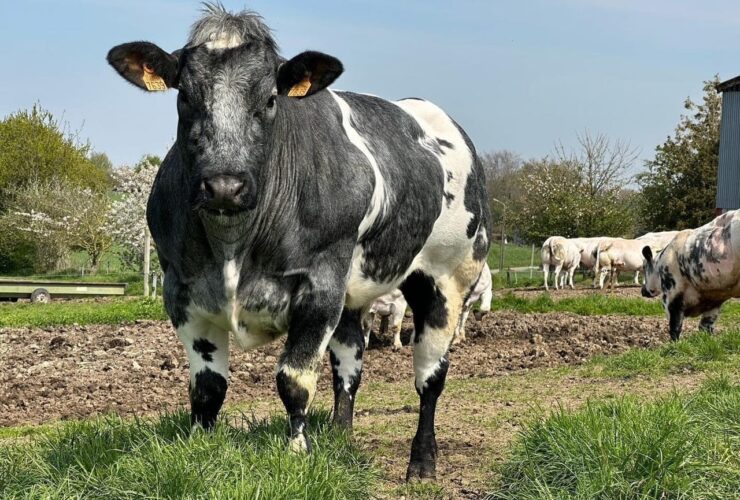Which beef has the most tender meat?
Not all beef is created equal. There are surely a lot of cow breeds that have an amazing flavor profile, but that still begs the question which beef has the most tender bite. And let’s be honest, a true beef lover is always looking for a smooth chewing experience that only makes you crave for more. There are several factors that determine the overall tenderness of beef, and we will cover them one by one. Let’s dive into it!

What determines the overall tenderness of beef?
There are several factors that define the overall tenderness of beef. The key ones are:
- The cut of beef (e.g. ribeye, sirloin, eye round, tenderloin)
- Genetics
- The cooking process

The cut of beef
Every beef lover knows that some cuts of beef are particularly more tender than others. Let’s dive into some well-known cuts of beef and compare their overall tenderness:
Tenderloin – tenderness score: 10/10
The king of tenderness will always be the tenderloin steak. This long piece of beef is cut from the oblong muscle (psoas major) and due to the lack of exercise during the lifespan of the cow, this cut is as tender as they come.
Ribeye and sirloin – tenderness score: 8/10
Next, we have the ribeye steak. This cut is not as tender as the tenderloin steak, but still has a decent texture that feels smooth while chewing your piece of beef. As ribeye steaks wield spectacular flavor, the ribeye is often the number one cut for many beef lovers around the world. When talking about tenderness, the sirloin steak is not far away of the ribeye steak. In fact, these two cuts are found right next to each other. Ribeye steaks are cut from the 6th rib to the 12th, starting from the chuck section all the way to the loin section, while sirloin steaks are cut from the 14th rib all the way to the end of the hip bone.
Eye round (supermarket steak) – tenderness score: 5/10
To really appreciate the tenderness of tenderloin, ribeye and sirloin steaks, they are best compared with regular eye round steaks that can easily be found in your local supermarket. As eye round steaks lack tenderness, they leave a chewy impression in the mouth which is not as pleasant as eating a supreme cut steak. This lies in the fact that eye rounds are cut from the rump and hind legs, which endure a lot of exercise during the lifespan of the cow. Once one is used to the distinctive tenderness of cuts like tenderloin, ribeye and sirloin, it may be hard for somer to enjoy a regular eye round.

Genetics
As stated earlier, not all beef is created equal, and that certainly refers to cow genetics. To clarify, there are simply cattle breeds that wield far tender beef than other breeds. Let’s dive into some different breeds to identify the difference:
Japanese Wagyu – tenderness score: 10/10
Japanese Wagyu is by far the most tender beef breed one can obtain. This lies in the fact that these steaks wield extremely high percentages of intramuscular fat. As fibers are just a combination of fat and actual beef, a bite from premium Japanese Wagyu will hardly give any resistance whatsoever. Combine that with an unmatched flavor experience, and you get the best beef in the world.
‘Double-muscle’ steaks – tenderness score: 10/10
Next to Wagyu, there are other breeds of beef that show excellent genetics with supreme tenderness. To clarify, Belgian Blue and Piedmontese are the only two cow breeds in the world that hold the ‘double-muscle’ gene. Due to this gene, these cows look giant and muscular. However, looks can be deceiving, as this genetic trait allows cows to develop very refined muscles, which finally results in the creation of extraordinarily tender beef. In addition, these cow breeds wield high levels of the myostatin protein, which boosts muscle differentiation and growth significantly.

The cooking process
Finally, we have come to the final step of the show: the cooking process. Different cooking methods wield different results concerning tenderness. Let’s discuss them:
Regular steak cuts like tenderloin, ribeye, sirloin and eye round should best be cooked hot and fast. Desired methods are the regular sear and the reverse sear. The desired cook for maximum tenderness is medium rare, nothing more and nothing less. However, feel free to experiment yourself using this guide on internal beef temperature.
Next, there are special cuts like brisket, beef short rib, knuckle and rib cap lifter. As these cuts are naturally very chewy and firm pieces of meat, they are best prepared low and slow. This leaves the meat to soften up during several hours of cooking on low temperature.

Conclusion
Searching the most tender beef there is can be quite the challenge. However, using this article as your guide, it will make things a lot easier. Be sure to always follow the given rules it terms of the right cut, the right breed, and the right cooking method.
Are you looking for one of the most tender beef brands out there, but still have troubles choosing? One of the prominent brands that have the double-muscle gene is Flanders Beef. It is a significantly cheaper cut than Japanese Wagyu, but nearly has the same tenderness due to superior genetics. Purchase your beef here!




